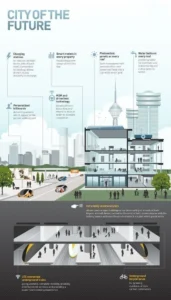Data-Driven Digital Architecture: Designing Smart and Sustainable Buildings
The Philosophy of Data-Driven Architecture
Data-driven digital architecture combines data science, technology, and building design. This approach allows architects to create flexible, sustainable, and user-centered spaces based on real behavior and needs. Data is no longer just a tool—it is a fundamental material of modern architecture.
Functions and User Experience in Smart Architecture
Spaces designed with a data-driven approach can support multiple uses and experiences simultaneously:
- Smart Homes: Lighting and energy flow are adjusted based on occupants’ presence.
- Smart Museums and Galleries: Visitor movement and exhibit layouts are redesigned using behavioral data.
- Smart Cities: Environmental data optimizes air quality, lighting, and sound to enhance citizen well-being.
This type of architecture improves space efficiency and enhances human experience.
Sustainability and Resource Optimization with Data
Data-driven architecture aligns with green and sustainable building practices:
- Smart energy management reduces electricity and water consumption and lowers the carbon footprint.
- Intelligent HVAC and lighting systems respond in real-time to data analysis.
- Use of recycled materials and optimized building maintenance.
Design Challenges and Solutions
Data-driven architecture comes with several challenges:
- Technology Scalability: Lighting, HVAC, and other systems must adapt to changing user needs.
- Data Privacy and Security: Collecting and analyzing data must comply with privacy regulations.
- Space Flexibility: Spaces should allow quick adaptation to different functions.
The Future of Digital Architecture and Smart Buildings
With the growth of IoT, artificial intelligence, and data analytics, data-driven architecture is becoming a global language for space design. Buildings and cities will not only be constructed—they will learn, adapt, and interact with users. Data-driven architecture is no longer optional; it is a necessity for modern, sustainable urban life.
Conclusion
Data-driven digital architecture merges art, data science, and smart building technology. It creates spaces that are intelligent, sustainable, and user-focused, enhancing urban living experiences. Data is no longer just a tool—it is the core material for the architecture of the future.




